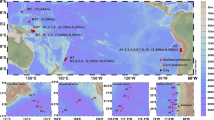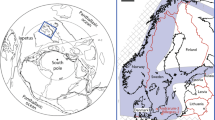Abstract
THE Black Sea, the world's largest anoxic marine basin, is frequently used as a modern analogue for the formation of organic-rich sediments and carbonaceous rocks1–3, on the widely held assumption that anoxic conditions promote the preferential preservation of organic matter in sediments. Data for testing this hypothesis have so far been equivocal4–7, but here we use radiocarbon ages obtained using accelerator mass spectrometry for the organic fraction of recent Black Sea sediments to estimate the organic carbon accumulation rates. These range from 0.69 to 2.09 g C m−2 yr−1 and are significantly lower than earlier estimates based on varve counting6. Depending on the value taken for the rate of primary production in the Black Sea4,8, between 0.7 and 2.1% of the organic carbon is preserved in the bottom sediments. When compared with carbon accumulation rates in equivalent oxygenated environments9, these results indicate that the modern Black Sea is not a site of anomalously high organic carbon accumulation. This suggests that anoxic conditions in the water column may not be a prerequisite for the preservation of organic matter in marine sediments, and that models of the origin of carbonaceous facies in the geological record may therefore need to be modified.
This is a preview of subscription content, access via your institution
Access options
Subscribe to this journal
Receive 51 print issues and online access
$199.00 per year
only $3.90 per issue
Buy this article
- Purchase on Springer Link
- Instant access to full article PDF
Prices may be subject to local taxes which are calculated during checkout
Similar content being viewed by others
References
Woolnough, W. G. Bull. Am. Ass. Petrol. Geol. 21, 1101–1157 (1937).
Thiede, J. & van Andel, T. H. Earth planet. Sci. 33, 301–309 (1977).
Demaison, G. J. & Moore, G. T. Org. Geochem. 2, 9–31 (1980).
Deuser, W. G. Deep-Sea Res. 18, 995–1004 (1971).
Calvert, S. E., Vogel, J. S. & Southon, J. R. Geology 15, 918–921 (1987).
Hay, B. J. Paleoceanography 3, 491–508 (1988).
Canfield, D. E. Deep-Sea Res. 36, 121–138 (1989).
Sorokin, Y. I. in Ecosystems of the World, Vol. 26: Estuaries and Enclosed Seas (ed. Ketchum, B. H.) (Elsevier, Amsterdam, 1983).
Müller, P. J. & Suess, E. Deep-Sea Res. 26, 1347–1362 (1979).
Ross, D. A., Degens, E. T. & Mcllvaine, J. Science 170, 163–165 (1970).
Kögler, F-C. Meyniana 13, 1–7 (1963).
Pilskaln, C. H. Trans. Am. Geophys. Un. 71, 151 (1990).
Slota, P. J., Jull, A. J. T., Linick, T. W. & Toolin, L. J. Radiocarbon 29, 303–306 (1987).
Linick, T. W., Jull, A. J. T., Toolin, L. J. & Donahue, D. J. Radiocarbon 28, 522–533 (1986).
Vogel, J. S., Southon, J. R., Nelson, D. E. & Brown, T. A. Nucl. Instrum. Meth. 233, 289–293 (1984).
Nelson, D. E., Vogel, J. S., Southon, J. R. & Brown, T. A. Radiocarbon 28, 215–222 (1986).
Degens, E. T. et al. Neues Jb. Geol. Paläontol. Mh. 1980, 65–86 (1980).
Honjo, S. et al. Mitt. Geol. Paläontol. Institut Univ. Hamburg 62, 19–39 (1987).
Hay, B. J. et al. Deep-Sea Res. 37, 911–928 (1990).
Broecker, W. S. & Peng, T-H. Tracers in the Sea, 690 (Eldigeo, Palisades, New York, 1982).
Murray, J. W., Top, Z. & Ozsoy, E. Deep-Sea Res. (in the press).
Jones, G. A. Trans. Am. Geophys. Un. 71, 152 (1990).
Crusius, J. & Anderson, R. Paleoceanography (submitted).
Vaynshteyn, M. B., Tokarev, V. G., Shakola, V. A., Lein, A. Y. & Ivanov, M. V. Geokhimiya 7, 1032–1044 (1985); (Engl. transl.) 110–122.
Henrichs, S. M. & Reeburgh, W. S. Geomicrobiol. J. 5, 191–237 (1987).
Pedersen, T. F. & Calvert, S. E. Bull. Am. Ass. Petrol. Geol. 74, 454–466 (1990).
Calvert, S. E. & Pedersen, T. F. in Productivity, Accumulation and Preservation of Organic Matter in Recent and Ancient Sediments (eds Whelan, J. K. & Farrington, J. W.) (Columbia University Press, in the press).
Karl, D. M. & Knauer, G. A. Deep-Sea Res. (in the press).
Sarnthein, M., Winn, K., Duplessy, J-C. & Fontugne, M. R. Paleoceanography 3, 361–399 (1988).
Author information
Authors and Affiliations
Rights and permissions
About this article
Cite this article
Calvert, S., Karlin, R., Toolin, L. et al. Low organic carbon accumulation rates in Black Sea sediments. Nature 350, 692–695 (1991). https://doi.org/10.1038/350692a0
Received:
Accepted:
Issue Date:
DOI: https://doi.org/10.1038/350692a0
This article is cited by
-
Intrusion of Arabian Sea high salinity water and monsoon-associated processes modulate planktic foraminiferal abundance and carbon burial in the southwestern Bay of Bengal
Environmental Science and Pollution Research (2024)
-
Manganese cycling in a eutrophic lake ? Rates and pathways
Aquatic Geochemistry (1996)
-
Comparison of anaerobic and aerobic biodegradation of mineralized skeletal structures in marine and estuarine conditions
Biogeochemistry (1994)
-
A 6,000–year sedimentary molecular record of chemocline excursions in the Black Sea
Nature (1993)
-
Tephra from the Minoan eruption of Santorini in sediments of the Black Sea
Nature (1993)
Comments
By submitting a comment you agree to abide by our Terms and Community Guidelines. If you find something abusive or that does not comply with our terms or guidelines please flag it as inappropriate.



